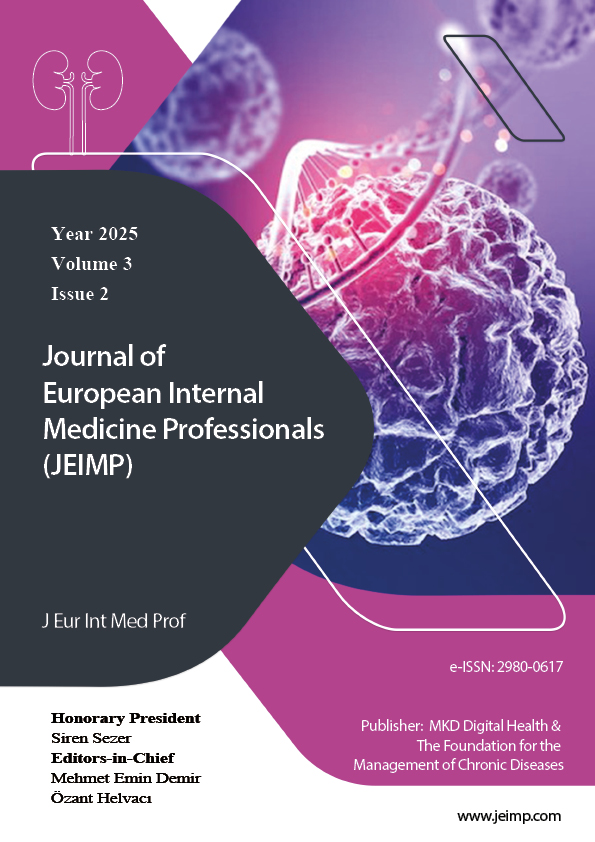Progestin Repairs the Mitochondria Membrane Potential by Preventing Membrane Hyperpolarization in Mitochondria Transferred Endometrial Stromal Cells
Progestin Effect on Mitochondria Transfer
DOI:
https://doi.org/10.5281/zenodo.15059099Keywords:
Dienogest, Stromal Cells, Membrane Potentials, Mitochondria, ProgestinAbstract
Background: The regenerative capacity of the endometrium is attributed to stem/progenitor cells. Despite their remarkable regenerative capacity, in some cases, impairments in regeneration can be observed. Endometrial mitochondria transplantation into the uterine cavity improves the uterine environment in Asherman’s syndrome. Mitochondria transfer shows therapeutic advantages by supporting tissue metabolism and viability. However, the disruptive environment of the endometrium could affect mitochondrial health adversely. Increasing mitochondrial activity with progestin protects against apoptosis. The aim was to investigate the effect of progestin supplementation during exogenous mitochondrial transplantation. The study was designed as an in vitro cell culture of endometrial stromal cells. Mitochondria were isolated from the same cell line, representing autologous mitochondria transplantation.
Method: The transplantation of mitochondria was detected by fluorescence labeling of mitochondria. Viability was assessed by CCK8, and apoptosis was detected by AnnexinV/PI staining. Gene expression analysis was performed for Ki67, p38, and Erk1/2.
Results: Mitochondria were successfully transferred into endometrial stromal cells. The viability was not significantly altered due to the exogenous mitochondria, despite the increase in the reactive oxygen level. The addition of progestin is also well tolerated. The combined application of both mitochondria and progestin further supports the viability of cells without inducing the level of reactive oxygen species. Apoptotic levels were decreased in the presence of progestin even in the co-transfection group of mitochondria and progestin. The mitochondrial cell membrane was evaluated with JC-1 showing that the disrupted membrane potential was recovered by progestin, improving the damaged membrane potential of the mitochondria.
Conclusion: The damaged membrane potential improved in the presence of progestin, helping to improve the overall output of the mitochondrial transplantation.
References
Cousins FL, Filby CE, Gargett CE. Endometrial stem/progenitor cells-their role in endometrial repair and regeneration. Front Reprod Health. 2022;3:811537. doi: 10.3389/frph.2021.811537.
Li T, Chan RWS, Li RHW, Ng EHY, Zhang S, Yeung WSB. Endometrial mesenchymal stromal/stem cells improve regeneration of injured endometrium in mice. Biol Res. 2024;57(1):6. doi: 10.1186/s40659-024-00484-3.
Gao Y, Wu G, Xu Y, Zhao D, Zheng L. Stem cell-based therapy for asherman syndrome: promises and challenges. Cell Transplant. 2021;30:9636897211020734. doi: 10.1177/09636897211020734.
Zhang Y, Shi L, Lin X, et al. Unresponsive thin endometrium caused by Asherman syndrome treated with umbilical cord mesenchymal stem cells on collagen scaffolds: a pilot study. Stem Cell Res Ther. 2021;12(1):420. doi: 10.1186/s13287-021-02499-z.
Azizi R, Aghebati-Maleki L, Nouri M, Marofi F, Negargar S, Yousefi M. Stem cell therapy in Asherman syndrome and thin endometrium: Stem cell- based therapy. Biomed Pharmacother. 2018;102:333-343. doi: 10.1016/j.biopha.2018.03.091.
Rungsiwiwut R, Virutamasen P, Pruksananonda K. Mesenchymal stem cells for restoring endometrial function: An infertility perspective. Reprod Med Biol. 2020;20(1):13-19. doi: 10.1002/rmb2.12339.
Song YT, Liu PC, Tan J, et al. Stem cell-based therapy for ameliorating intrauterine adhesion and endometrium injury. Stem Cell Res Ther. 2021;12(1):556. doi: 10.1186/s13287-021-02620-2.
Shi J, Tan X, Feng G, et al. Corrigendum: Research advances in drug therapy of endometriosis. Front Pharmacol. 2023;14:1274946. doi:10.3389/fphar.2023.1274946.
Uzelli Şimşek H, Şimşek T, Duruksu G, Furat Rençber S, Yazır Y. Different Effect of Dienogest on Endometrium Mesenchymal Stem Cells Derived from Healthy and Endometriosis Tissues. Balkan Med J. 2024;41(6):484-490. doi: 10.4274/balkanmedj.galenos.2024.2024-6-95.
Björk E, Israelsson P, Nagaev I, et al. Endometriotic Tissue-derived Exosomes Downregulate NKG2D-mediated Cytotoxicity and Promote Apoptosis: Mechanisms for Survival of Ectopic Endometrial Tissue in Endometriosis. J Immunol. 2024;213(5):567-576. doi: 10.4049/jimmunol.2300781.
Chen TQ, Wei XJ, Liu HY, Zhan SH, Yang XJ. Telocyte-Derived Exosomes Provide an Important Source of Wnts That Inhibits Fibrosis and Supports Regeneration and Repair of Endometrium. Cell Transplant. 2023;32:9636897231212746. doi: 10.1177/09636897231212746.
Zhao S, Qi W, Zheng J, et al. Exosomes Derived from Adipose Mesenchymal Stem Cells Restore Functional Endometrium in a Rat Model of Intrauterine Adhesions. Reprod Sci. 2020;27(6):1266-1275. doi: 10.1007/s43032-019-00112-6.
Brestoff JR, Singh KK, Aquilano K, et al. Recommendations for mitochondria transfer and transplantation nomenclature and characterization. Nat Metab. 2025;7(1):53-67. doi: 10.1038/s42255-024-01200-x.
Nicolás-Ávila JA, Lechuga-Vieco AV, Esteban-Martínez L, et al. A Network of Macrophages Supports Mitochondrial Homeostasis in the Heart. Cell. 2020;183(1):94-109.e23. doi: 10.1016/j.cell.2020.08.031.
Brestoff JR, Wilen CB, Moley JR, et al. Intercellular Mitochondria Transfer to Macrophages Regulates White Adipose Tissue Homeostasis and Is Impaired in Obesity. Cell Metab. 2021;33(2):270-282.e8. doi: 10.1016/j.cmet.2020.11.008.
Kidwell CU, Casalini JR, Pradeep S, et al. Transferred mitochondria accumulate reactive oxygen species, promoting proliferation. Elife. 2023;12:e85494. doi: 10.7554/eLife.85494.
Marlein CR, Zaitseva L, Piddock RE, et al. NADPH oxidase-2 derived superoxide drives mitochondrial transfer from bone marrow stromal cells to leukemic blasts. Blood. 2017;130(14):1649-1660. doi: 10.1182/blood-2017-03-772939.
Jiang Z, Shi C, Han H, et al. Autologous non-invasively derived stem cells mitochondria transfer shows therapeutic advantages in human embryo quality rescue. Biol Res. 2023;56(1):60. doi: 10.1186/s40659-023-00470-1.
Hwang SY, Lee D, Lee G, et al. Endometrial organoids: a reservoir of functional mitochondria for uterine repair. Theranostics. 2024;14(3):954-972. doi: 10.7150/thno.90538.
Rencber SF, Yazır Y, Sarıhan M, et al. Endoplasmic reticulum stress of endometrial mesenchymal stem cells in endometriosis. Tissue Cell. 2024;91:102544. doi: 10.1016/j.tice.2024.102544.
Strowitzki T, Faustmann T, Gerlinger C, Seitz C. Dienogest in the treatment of endometriosis- associated pelvic pain: a 12-week, randomized, double-blind, placebo-controlled study. Eur J Obstet Gynecol Reprod Biol. 2010;151:193-198.
Strowitzki T, Faustmann T, Gerlinger C, Schumacher U, Ahlers C, Seitz C. Safety and tolerability of dienogest in endometriosis: Pooled analysis from the European clinical study program. Int. J. Women’s Health. 2015;7:391–401.
Jeng CJ, Chuang L, Shen J. A comparison of progestogens or oral contraceptives and gonadotropin- releasing hormone agonists for the treatment of endometriosis: a systematic review. Expert Opin Pharmacother. 2014;15:767-773.
Türkiye Endometriozis Tanı ve Yönetim Kılavuzu 2014, Endometriozis Adenomyozis Derneği 2009, Oral E, Api M, Ata B, et al., 2014; 1. Baskı, 1-110
Meresman GF, Auge L, Baranao RI, Lombardi E, Tesone M, Sueldo C. Oral contraceptive suppress cell proliferation and enhance apoptosis of eutopic endometrial tissue from patients with endometriosis. Fertil Steril. 2002;77:1141–1147.
Vercellini P, Fedele L, Pietropaolo G, Frontino G, Somigliana E, Crosignani PG. Progestogens for endometriosis: forward to the past. Hum Reprod Update. 2003;9:387-396.
Kim HJ, Kim SH, Oh YS, Lee SR, Chae HD. Dienogest May Reduce Estradiol- and Inflammatory Cytokine-Induced Cell Viability and Proliferation and Inhibit the Pathogenesis of Endometriosis: A Cell Culture- and Mouse Model-Based Study. Biomedicines. 2022;10(11):2992. doi: 10.3390/biomedicines10112992.
Turk H. Progesterone Promotes Mitochondrial Respiration at the Biochemical and Molecular Level in Germinating Maize Seeds. Plants (Basel). 2021;10(7):1326. doi: 10.3390/plants10071326.
Behera MA, Dai Q, Garde R, Saner C, Jungheim E, Price TM. Progesterone stimulates mitochondrial activity with subsequent inhibition of apoptosis in MCF-10A benign breast epithelial cells. Am J Physiol Endocrinol Metab. 2009;297(5):E1089-1096. doi: 10.1152/ajpendo.00209.2009.
Moreno-Sánchez R, Rodríguez-Enríquez S, Marín-Hernández A, Saavedra E. Energy metabolism in tumor cells. FEBS J. 2007;274(6):1393-1418. doi: 10.1111/j.1742-4658.2007.05686.x.
Jiang Z, Hu X, Yu H, et al. Human endometrial stem cells confer enhanced myocardial salvage and regeneration by paracrine mechanisms. J Cell Mol Med. 2013;17(10):1247-1260. doi: 10.1111/jcmm.12100.
Hamanaka RB, Chandel NS. Mitochondrial reactive oxygen species regulate cellular signaling and dictate biological outcomes. Trends Biochem Sci. 2010;35(9):505-513. doi: 10.1016/j.tibs.2010.04.002.
Hong Y, Boiti A, Vallone D, Foulkes NS. Reactive Oxygen Species Signaling and Oxidative Stress: Transcriptional Regulation and Evolution. Antioxidants (Basel). 2024;13(3):312. doi: 10.3390/antiox13030312.
Wang Z, Kyo S, Takakura M, et al. Progesterone regulates human telomerase reverse transcriptase gene expression via activation of mitogen-activated protein kinase signaling pathway. Cancer Res. 2000;60(19):5376-5381.
Taheri M, Ghafouri-Fard S, Najafi S, et al. Hormonal regulation of telomerase activity and hTERT expression in steroid-regulated tissues and cancer. Cancer Cell Int. 2022;22(1):258. doi: 10.1186/s12935-022-02678-9.
Andrabi SS, Parvez S, Tabassum H. Progesterone induces neuroprotection following reperfusion-promoted mitochondrial dysfunction after focal cerebral ischemia in rats. Dis Model Mech. 2017;10(6):787-796. doi: 10.1242/dmm.025692.
Tantibhedhyangkul J, Hawkins KC, Dai Q, et al. Expression of a mitochondrial progesterone receptor in human spermatozoa correlates with a progestin-dependent increase in mitochondrial membrane potential. Andrology. 2014;2(6):875-883. doi: 10.1111/j.2047-2927.2014.00263.x.
Downloads
Published
How to Cite
Issue
Section
Categories
License
Copyright (c) 2025 Hayal Uzelli Şimşek

This work is licensed under a Creative Commons Attribution 4.0 International License.










